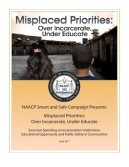A New Report From NAACP | http://bit.ly/fHBF0L

On April 7th, the NAACP released a new report, Misplaced Priorities, that examines America's escalating levels of prison spending and its impact on state budgets and our nation’s children.

The report is part of the NAACP’s “Smart and Safe Campaign,” and offers a set of recommendations that will help policymakers in all 50 states downsize prison populations and shift the savings to education budgets.
Below are profiles of the six cities studied in the report, as well as three profiled individuals. The full report follows.
MISPLACED PRIORITIES: Los Angeles, CA
More than 50 percent of the people who were in prison, and are now on parole in Los Angeles live in zip codes that are home to only 18 percent of the city's adults. This means that more than a billion taxpayer dollars are spent every year to incarcerate people from Los Angeles neighborhoods where less than 20 percent of Los Angeles residents live.
We also know that in Los Angeles, 69 of the 90 (67 percent) low performing schools are in neighborhoods with the highest incarceration rates. By contrast, 59 of the city's 86 high performing schools (68 percent) are in neighborhoods with the lowest incarceration rates.

© 2009 - 2011 National Association for the Advancement of Colored People
City Profiles:Houston, TXIn Houston, taxpayers spent over $175 million to imprison residents sentenced in 2008 from just 10 of the 75 neighborhoods in Houston. While these neighborhoods are home to only about 10 percent of the city’s population, they account for nearly a third of the estimated $500 million spent to imprison people sentenced in 2008 from all of Houston. Read more. Indianapolis, INHundreds of millions of dollars are being spent by taxpayers to imprison people from Indiana’s biggest city, Indianapolis. 41% of those sent to prison from Indianapolis each year come from zip codes that account for just 16% of the city’s population. Read more. Jackson, MSAs Jackson’s education system experiences budget cuts, taxpayers are spending $24 million a year to imprison people from Jackson neighborhoods. While these neighborhoods are home to just over half of the city’s population, they account for over two-thirds of the total estimated $35 million spent to imprison people sentenced in 2008 from all of Jackson. Read more.
New York, NYWhile the education system of New York city lost hundreds of millions of dollars in state and city funding, taxpayers spent over half a billion dollars ($539 million) to imprison residents sentenced in 2008. These residents came from twenty-four of New York City neighborhoods representing just over half of the $1.1 billion in funds spent to imprison people from New York City. Read more. Philadelphia, PAIn Philadelphia, taxpayers spent nearly $290 million to imprison residents sentenced from just 11 of the city’s neighborhoods. While these neighborhoods are home to just over one-quarter of the city’s population, they account for more than half of the over $500 million dollars spent to imprison people sentenced in all of Philadelphia. Read more. | Case Studies:Marlo A. Hargrove Sr, Baltimore MD Hargrove was born into a family where both parents suffered from alcoholism. He started selling drugs at age 10 and using drugs by age 12, eventually dropping out of high school in the ninth grade. He became a serious drug abuser and found himself engaged in a "revolving door experience with the Department of Corrections". He was incarcerated multiple times for drug use and alcohol abuse, becoming, in his words, a "jailbird". Kenny Harrigan, New York, NY In 1988, Mr. Harrigan was homeless and had a drug abuse issue. He was attempting to protect his belongings (including ID, birth certificate, etc.) from the rain and from falling into others' hands, so he went to put his things in a tool shed that was in the yard of a house. He never made it inside, was at the window, when someone called the police. The police came and arrested him, he plead guilty to 2nd degree burglary and served 6 months with 5 years probation. Hamedah Hasan, Nebraska Hamedah Hasan, a grandmother and mother of 3, she was convicted for playing a peripheral role in a crack cocaine conspiracy headed by a family member. Hamedah had fled a physically abusive relationship and sought shelter with her cousin, who after several months began asking to her run minor errands for the operation. Hamedah’s was a first time, nonviolent offense. Although she never used drugs and felt she had no choice but to participate at the time, Hamedah admittedly chose to engage in the wrong doing. |







No comments:
Post a Comment